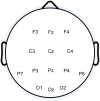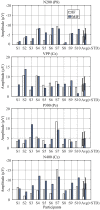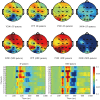Optimizing the Face Paradigm of BCI System by Modified Mismatch Negative Paradigm
- PMID: 27774046
- PMCID: PMC5054457
- DOI: 10.3389/fnins.2016.00444
Optimizing the Face Paradigm of BCI System by Modified Mismatch Negative Paradigm
Abstract
Many recent studies have focused on improving the performance of event-related potential (ERP) based brain computer interfaces (BCIs). The use of a face pattern has been shown to obtain high classification accuracies and information transfer rates (ITRs) by evoking discriminative ERPs (N200 and N400) in addition to P300 potentials. Recently, it has been proved that the performance of traditional P300-based BCIs could be improved through a modification of the mismatch pattern. In this paper, a mismatch inverted face pattern (MIF-pattern) was presented to improve the performance of the inverted face pattern (IF-pattern), one of the state of the art patterns used in visual-based BCI systems. Ten subjects attended in this experiment. The result showed that the mismatch inverted face pattern could evoke significantly larger vertex positive potentials (p < 0.05) and N400s (p < 0.05) compared to the inverted face pattern. The classification accuracy (mean accuracy is 99.58%) and ITRs (mean bit rate is 27.88 bit/min) of the mismatch inverted face pattern was significantly higher than that of the inverted face pattern (p < 0.05).
Keywords: N400; P300; brain computer interface; face paradigm; online system.
Figures






Similar articles
-
Exploring Combinations of Different Color and Facial Expression Stimuli for Gaze-Independent BCIs.Front Comput Neurosci. 2016 Jan 29;10:5. doi: 10.3389/fncom.2016.00005. eCollection 2016. Front Comput Neurosci. 2016. PMID: 26858634 Free PMC article.
-
A P300 brain-computer interface based on a modification of the mismatch negativity paradigm.Int J Neural Syst. 2015 May;25(3):1550011. doi: 10.1142/S0129065715500112. Epub 2015 Feb 26. Int J Neural Syst. 2015. PMID: 25804352
-
An ERP-based BCI using an oddball paradigm with different faces and reduced errors in critical functions.Int J Neural Syst. 2014 Dec;24(8):1450027. doi: 10.1142/S0129065714500270. Epub 2014 Sep 2. Int J Neural Syst. 2014. PMID: 25182191
-
A survey of the dummy face and human face stimuli used in BCI paradigm.J Neurosci Methods. 2015 Jan 15;239:18-27. doi: 10.1016/j.jneumeth.2014.10.002. Epub 2014 Oct 12. J Neurosci Methods. 2015. PMID: 25314905
-
The Self-Face Paradigm Improves the Performance of the P300-Speller System.Front Comput Neurosci. 2020 Jan 15;13:93. doi: 10.3389/fncom.2019.00093. eCollection 2019. Front Comput Neurosci. 2020. PMID: 32009923 Free PMC article.
Cited by
-
Effects of Skin Friction on Tactile P300 Brain-Computer Interface Performance.Comput Intell Neurosci. 2021 Feb 9;2021:6694310. doi: 10.1155/2021/6694310. eCollection 2021. Comput Intell Neurosci. 2021. PMID: 33628218 Free PMC article.
-
Comparison of the ERP-Based BCI Performance Among Chromatic (RGB) Semitransparent Face Patterns.Front Neurosci. 2020 Jan 31;14:54. doi: 10.3389/fnins.2020.00054. eCollection 2020. Front Neurosci. 2020. PMID: 32082118 Free PMC article.
-
Psychological Predictors of Visual and Auditory P300 Brain-Computer Interface Performance.Front Neurosci. 2018 May 14;12:307. doi: 10.3389/fnins.2018.00307. eCollection 2018. Front Neurosci. 2018. PMID: 29867319 Free PMC article.
-
Effects of Visual Attention on Tactile P300 BCI.Comput Intell Neurosci. 2020 Feb 19;2020:6549189. doi: 10.1155/2020/6549189. eCollection 2020. Comput Intell Neurosci. 2020. PMID: 32148471 Free PMC article.
References
-
- Duncan C. C., Barry R. J., Connolly J. F., Fischer C., Michie P. T., Näätänen R., et al. . (2009). Event-related potentials in clinical research: guidelines for eliciting, recording, and quantifying mismatch negativity, P300, and N400. Clin. Neurophysiol. 120, 1883–1908. 10.1016/j.clinph.2009.07.045 - DOI - PubMed
LinkOut - more resources
Full Text Sources
Other Literature Sources
Miscellaneous

